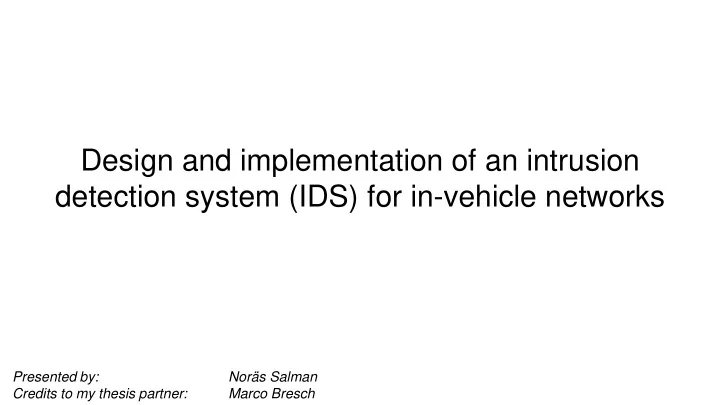

Design and implementation of an intrusion detection system (IDS) for in-vehicle networks Presented by: Noräs Salman Credits to my thesis partner: Marco Bresch
Brief background: in-vehicle networks ● Controller Area Network (CAN) ● MOST ● FlexRay ● LIN ● Ethernet 2
Brief background: CAN (frames & signals) ● Very well defined frame that carries multiple signals. 3
Brief background: CAN (signal database) 4
Brief background: CAN security Receiving Node Receiving Node Dropping Broadcasting Sniffing Sending Node Tampering of legitimate frames Injecting of arbitrary frames + DoS 5 Collision Avoidance
Mission briefing Scientific Questions: - How is an in-vehicle network IDS designed? - How to design its rules? - Limitations and challenges? → Implementation of an prototype IDS which can detect attacks on the network Scope: No prevention and no alarming of attacks, focused on the Controller Area Network 6
Preceding ideas, efforts and research (defense) How to defend against in-vehicle networks attacks? - Encryption of communication - Cryptographic signatures / certificates - Intrusion Detection Systems Machine learning approaches - Specification-based - Anomaly-based - Previous research is dominated by anomaly-based solutions 7
Setup (Simulated network) ● Safer to start with. ● Easy to add nodes ● Can overwrite ECU code. Nodes we add: IDS Attacker 8
Setup (Box car) ● More complicated topology 9
Setup (Box car) - Can’t overwrite the code for any ECU - Connected to only one domain at a time. - We can add more (virtual) nodes. Virtual nodes we add: IDS Attacker 10
Design Snort (Computer System) Our design (in-vehicle IDS) 11
Implementation - Specification-based rules - Malformed frame detection - Unauthorized message detection - Anomaly-based algorithms - Plausibility detection (Detect sudden shifts in speed signal values) - Frequency change detection (Generic way to detect message injection) 12
Specification-based detection ● Malformed frame detection ○ Rules extracted from signal database and compared directly. ● Unauthorized message detection ○ White-list extracted from the signal database. White-list 13
Results (Specification-based detection) ● Performed attacks on different domains for evaluation ● The results were as expected → 100% Detection rate Test 1 Virtual attacker node + Virtual IDS node Test 2 Virtual attacker node + Virtual IDS node 14
Anomaly based detection (plausibility detection) - We focused on speed signals - It's not normal to see the speedometer jump from 30 km/h to 200 km/h in one second. - Change in value between two consecutive messages has a threshold that depends on the acceleration capabilities and the driver’s behaviour . 15
Anomaly based detection (plausibility detection) Extracting a threshold (Use case) - Acceleration simulation. - 4000 messages (20 seconds) - Speed difference between (t) and (t-1) Algorithm simplified x = abs( speed(t)-speed(t-1) ) Threshold = 20 (raw) ≈ 16 (km/h) if (x >= threshold) → raise an alarm 16
Results (plausibility detection) Two tests ● Constant speed injection ○ Injected speed value is constant during the attack ● Stealth speed injection ○ Injected speed value is changing during the attack We can detect the start and the end of the attack 17
Anomaly based detection (frequency detection) ● The cycle time is defined in the signal database. ● This was not enough because it resulted in false detections. ● Solution: (Double check) Algorithm simplified attack = false First if( (T(m t )-T(m t-1 ) < cycle_time){ check attack =true Irregular shifts attack_count++ (clock skew) Second if (attack_count > 1) check → raise an alarm } if(!attack && count>0){ attack_count=0 The message here has 2 ms as cycle time 18 }
Results (Frequency change detection) Two tests ● Cycle time effect Identical cycle time ● Aggressive injection (Dos) Smaller cycle time Aggressive injection 19
Challenges and limitations ● Hardware constraints ○ ECUs have limited capabilities, but we didn’t have a problem with that. ● IDS node placement = cost ○ We suggest placing an IDS node in each domain for full coverage and lower load. ● Data selection ○ Plausibility detection should depend on acceleration capabilities, we only used a simulation ● Log storage? rule update? 20
Summary - Security is a problem in modern vehicles. - We designed and implement an IDS system using distributed IDS nodes (ECUs) around the different domains. - Each IDS node has a combination of : - Specification based rules - Anomaly based algorithms - No false positives - Challenges for future research. 21
Thank you for listening 22
Frequency detection vs plausibility detection Monitors the signal’s value Monitors the message frequency Detects the whole attack Detects the beginning and the end of an attack 23
Recommend
More recommend